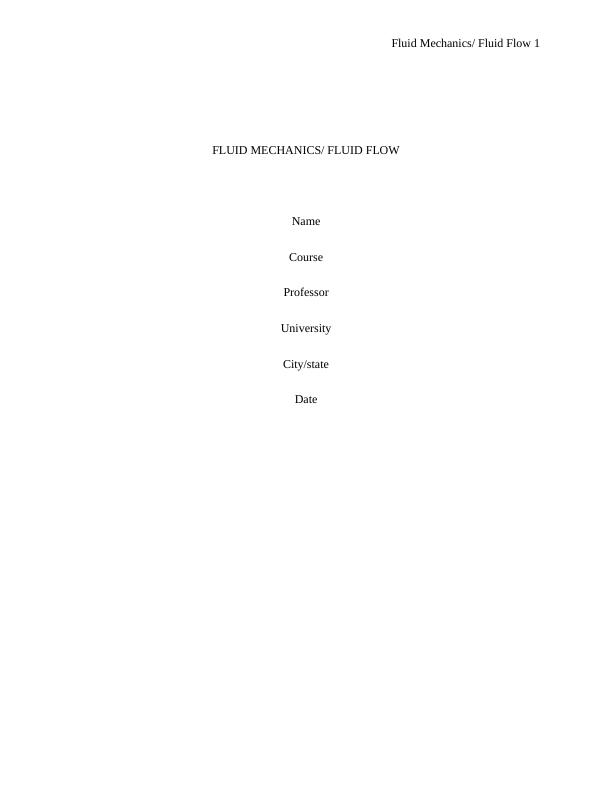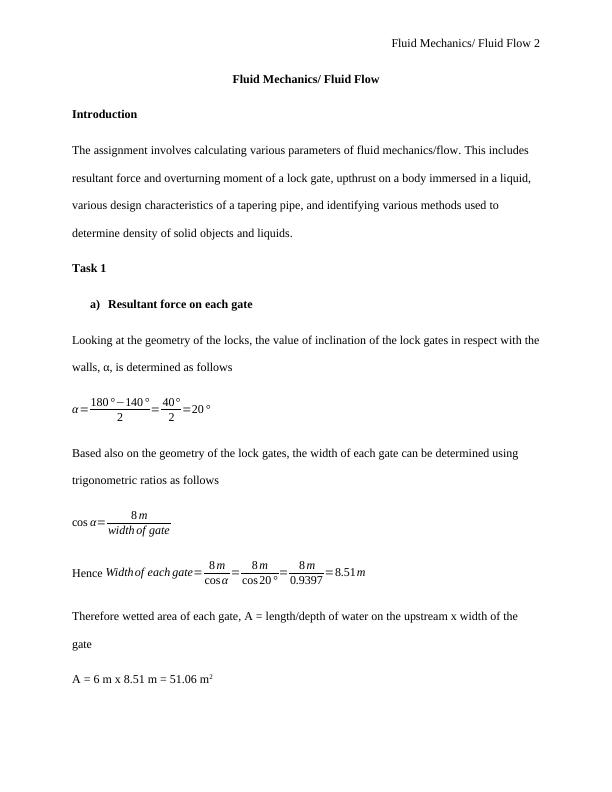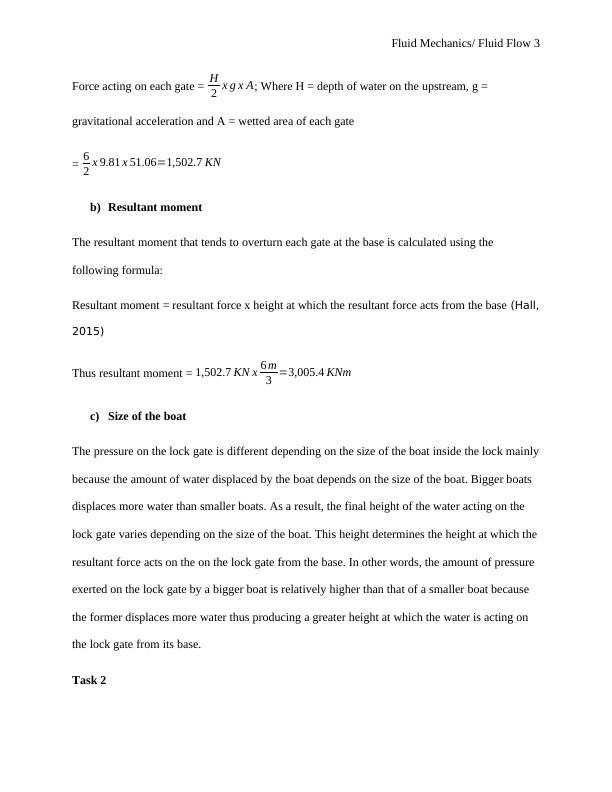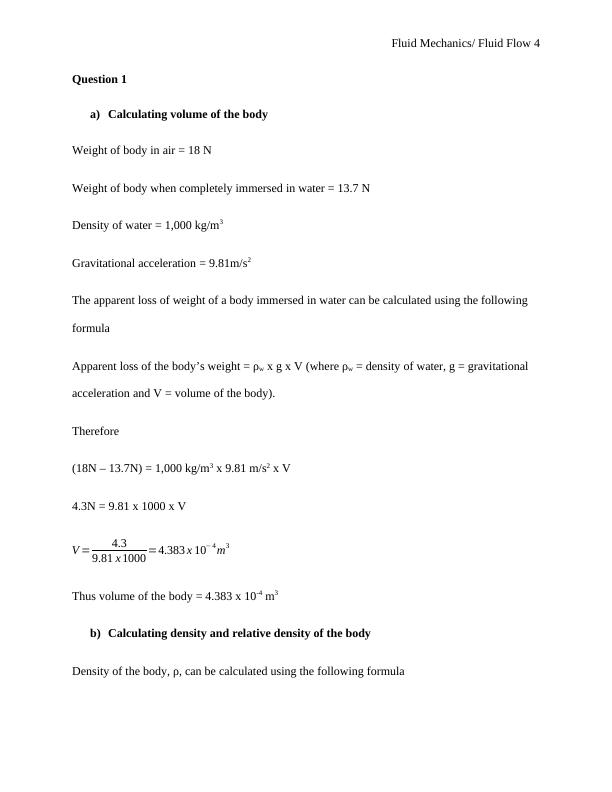Fluid Mechanics/ Fluid Flow 13
Added on 2022-11-03
13 Pages2205 Words118 Views
Fluid Mechanics/ Fluid Flow 1
FLUID MECHANICS/ FLUID FLOW
Name
Course
Professor
University
City/state
Date
FLUID MECHANICS/ FLUID FLOW
Name
Course
Professor
University
City/state
Date

Fluid Mechanics/ Fluid Flow 2
Fluid Mechanics/ Fluid Flow
Introduction
The assignment involves calculating various parameters of fluid mechanics/flow. This includes
resultant force and overturning moment of a lock gate, upthrust on a body immersed in a liquid,
various design characteristics of a tapering pipe, and identifying various methods used to
determine density of solid objects and liquids.
Task 1
a) Resultant force on each gate
Looking at the geometry of the locks, the value of inclination of the lock gates in respect with the
walls, α, is determined as follows
α = 180 °−140 °
2 = 40°
2 =20 °
Based also on the geometry of the lock gates, the width of each gate can be determined using
trigonometric ratios as follows
cos α= 8 m
width of gate
Hence Width of each gate= 8 m
cos α = 8 m
cos 20 ° = 8 m
0.9397 =8.51m
Therefore wetted area of each gate, A = length/depth of water on the upstream x width of the
gate
A = 6 m x 8.51 m = 51.06 m2
Fluid Mechanics/ Fluid Flow
Introduction
The assignment involves calculating various parameters of fluid mechanics/flow. This includes
resultant force and overturning moment of a lock gate, upthrust on a body immersed in a liquid,
various design characteristics of a tapering pipe, and identifying various methods used to
determine density of solid objects and liquids.
Task 1
a) Resultant force on each gate
Looking at the geometry of the locks, the value of inclination of the lock gates in respect with the
walls, α, is determined as follows
α = 180 °−140 °
2 = 40°
2 =20 °
Based also on the geometry of the lock gates, the width of each gate can be determined using
trigonometric ratios as follows
cos α= 8 m
width of gate
Hence Width of each gate= 8 m
cos α = 8 m
cos 20 ° = 8 m
0.9397 =8.51m
Therefore wetted area of each gate, A = length/depth of water on the upstream x width of the
gate
A = 6 m x 8.51 m = 51.06 m2

Fluid Mechanics/ Fluid Flow 3
Force acting on each gate = H
2 x g x A; Where H = depth of water on the upstream, g =
gravitational acceleration and A = wetted area of each gate
= 6
2 x 9.81 x 51.06=1,502.7 KN
b) Resultant moment
The resultant moment that tends to overturn each gate at the base is calculated using the
following formula:
Resultant moment = resultant force x height at which the resultant force acts from the base (Hall,
2015)
Thus resultant moment = 1,502.7 KN x 6 m
3 =3,005.4 KNm
c) Size of the boat
The pressure on the lock gate is different depending on the size of the boat inside the lock mainly
because the amount of water displaced by the boat depends on the size of the boat. Bigger boats
displaces more water than smaller boats. As a result, the final height of the water acting on the
lock gate varies depending on the size of the boat. This height determines the height at which the
resultant force acts on the on the lock gate from the base. In other words, the amount of pressure
exerted on the lock gate by a bigger boat is relatively higher than that of a smaller boat because
the former displaces more water thus producing a greater height at which the water is acting on
the lock gate from its base.
Task 2
Force acting on each gate = H
2 x g x A; Where H = depth of water on the upstream, g =
gravitational acceleration and A = wetted area of each gate
= 6
2 x 9.81 x 51.06=1,502.7 KN
b) Resultant moment
The resultant moment that tends to overturn each gate at the base is calculated using the
following formula:
Resultant moment = resultant force x height at which the resultant force acts from the base (Hall,
2015)
Thus resultant moment = 1,502.7 KN x 6 m
3 =3,005.4 KNm
c) Size of the boat
The pressure on the lock gate is different depending on the size of the boat inside the lock mainly
because the amount of water displaced by the boat depends on the size of the boat. Bigger boats
displaces more water than smaller boats. As a result, the final height of the water acting on the
lock gate varies depending on the size of the boat. This height determines the height at which the
resultant force acts on the on the lock gate from the base. In other words, the amount of pressure
exerted on the lock gate by a bigger boat is relatively higher than that of a smaller boat because
the former displaces more water thus producing a greater height at which the water is acting on
the lock gate from its base.
Task 2

Fluid Mechanics/ Fluid Flow 4
Question 1
a) Calculating volume of the body
Weight of body in air = 18 N
Weight of body when completely immersed in water = 13.7 N
Density of water = 1,000 kg/m3
Gravitational acceleration = 9.81m/s2
The apparent loss of weight of a body immersed in water can be calculated using the following
formula
Apparent loss of the body’s weight = ρw x g x V (where ρw = density of water, g = gravitational
acceleration and V = volume of the body).
Therefore
(18N – 13.7N) = 1,000 kg/m3 x 9.81 m/s2 x V
4.3N = 9.81 x 1000 x V
V = 4.3
9.81 x 1000 =4.383 x 10− 4 m3
Thus volume of the body = 4.383 x 10-4 m3
b) Calculating density and relative density of the body
Density of the body, ρ, can be calculated using the following formula
Question 1
a) Calculating volume of the body
Weight of body in air = 18 N
Weight of body when completely immersed in water = 13.7 N
Density of water = 1,000 kg/m3
Gravitational acceleration = 9.81m/s2
The apparent loss of weight of a body immersed in water can be calculated using the following
formula
Apparent loss of the body’s weight = ρw x g x V (where ρw = density of water, g = gravitational
acceleration and V = volume of the body).
Therefore
(18N – 13.7N) = 1,000 kg/m3 x 9.81 m/s2 x V
4.3N = 9.81 x 1000 x V
V = 4.3
9.81 x 1000 =4.383 x 10− 4 m3
Thus volume of the body = 4.383 x 10-4 m3
b) Calculating density and relative density of the body
Density of the body, ρ, can be calculated using the following formula

End of preview
Want to access all the pages? Upload your documents or become a member.
Related Documents
BTEC Level 3 Diploma In Mechanical Engineeringlg...
|11
|1401
|53
Pressure Transmission Assignment PDFlg...
|9
|1317
|192
The Assignment on Impact of Jet Introductionlg...
|7
|1206
|22
